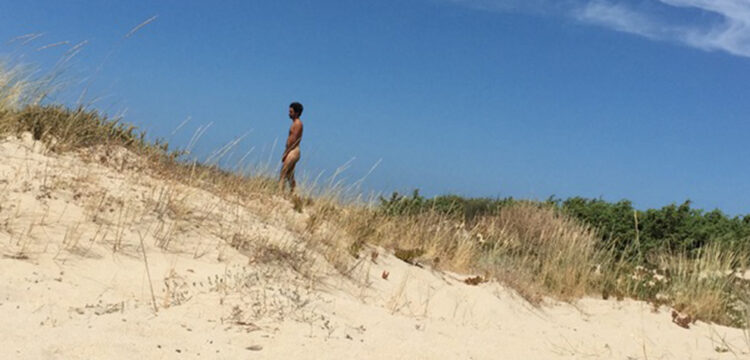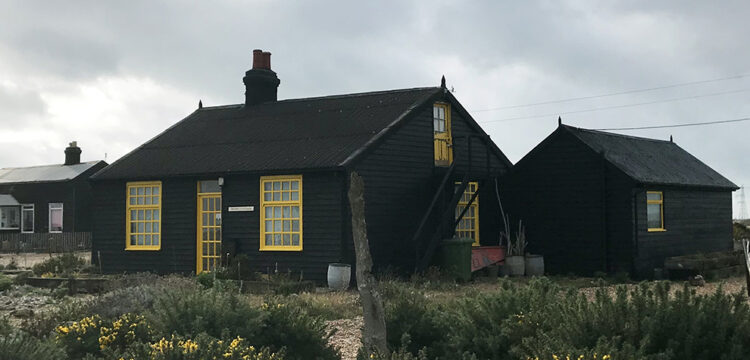Embracing Thingness
A conversation between Ilenia Caleo and Simone Aughterlony
Biofiction is an unusual love story involving many players, an unexpected clearing in untamed nature, a close-up of human and non-human assemblages and their affections, that creates a new horizontal terrain that offers a plurality of beings without any ontological hierarchy. What may be considered an inadequate stimulus in daily life is explored for its specific and sensual qualities, revealing an irrational love of matter. The intimate relationship, the dance that evokes actions relating to work, pleasure, coexistence and simply “being with” rejects the codified division between nature and culture, male and female, and every other kind of binary vision. The practice spawns a queer conscience and builds a landscape that is both present and utopian.
The work was performed by Simone Aughterlony, Jen Rosenblit and Hahn Rowe at re-creatures, the summer program curated by Ilaria Mancia for Mattatoio. The performance was followed by a conversation between Simone Aughterlony and Ilenia Caleo, that we are very glad to publish in a re-edited version.
Ilenia Caleo: I would take off from a text of feminist political theory Vibrant Matter: A Political Ecology of Things by philosopher Jane Bennett, you used as reference for your piece and it is in fact very much in contact with Biofiction. The whole debate around feminist and transfeminist thought that is currently being produced, and this text in particular, unfolds through a reflection and an articulation around matter and the idea of an active matter—a matter with agency, within the attempt to break the usual association between matter and passivity, that is to speak of matter as something passive and inert—already formed, severed and opaque; as something that is mechanical, therefore it needs an active principle that does not belong to itself but rather to a force that must come from outside to animate it.
This is a strongly political shift—because we could ask ourselves what triggers us politically about a thought on this subject, particularly in terms of feminist queer politics—because it opens up new perspectives. First of all, matter is traditionally associated with nature as a passive principle, inasmuch as the feminine is. So here, the first step is precisely this refusal—of this association and others. This was one of the historical shifts within feminist thought, to say that we are not only nature, in order to reject the connotation according to which nature and matter are not just a passive principle. This way of thinking matter as something inert and passive feeds fantasies of domination and conquest, like the idea, for example, that there are natural resources available for free that can be freely accessed, as some sort of infinite source of natural resources, territories and raw materials. The principles of new queer ecologies are born from this idea. And here too, there is another entanglement between accessible resources and “freely available” bodies, within sex work or women labour, wherein “women” is meant not as a biological identity but as gendered political subjects. Therefore, in overturning and rejecting the idea of matter as a passive principle, there is a political loophole for a new approach toward bodies and matter—toward a new ecology.
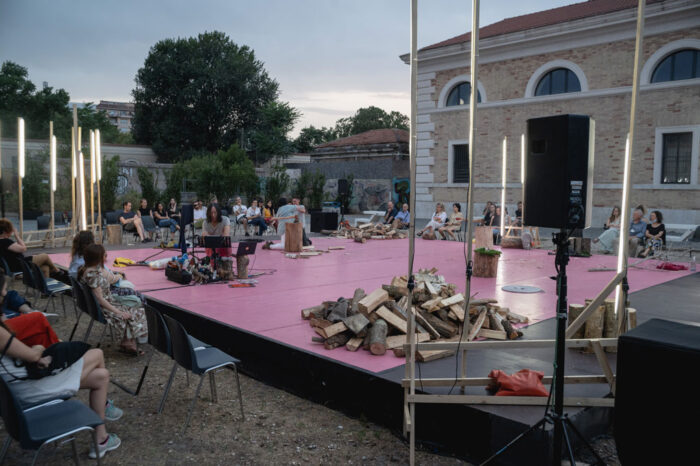
Speaking of Biofiction as an affective score, I would say it also covers the possibility of creating new aesthetics stemming from the very same idea. For me, this text by Bennett also deeply questions the performative practice at large and seems to resonate with Simone’s work, beginning with the possibility of rendering invisible forces visible, and this is something that this space—the live art space—manages to do. “The force of things” says Bennett—the book begins just like that: she walks down the street and looks, her eye falls on a series of objects such as the grate on the sidewalk, a plastic glove, a wooden stick, the plastic cap of a bottle, a dead mouse, a thick layer of pollen. She looks at them and is struck by the strength of this assemblage that is made up, not as something that is more than, but the sum of these objects is rather something in itself. She begins to think there is something inside the term thing that is stronger than the word object, something that gives us the idea of an active assemblage, something that can free the object from the commodity, again by making those invisible forces visible.
Another element is already in the title Vibrant Matter—as vibration or vibrating quality, a principle of movement that does not belong only to the human or living realm. We can think of movement or geological forces we do not register for example. In the entire score here, in Simone’s work, vibration becomes a compositional principle. Some boundaries begin to fade—between organic and inorganic, between human and non-human, between animate and inanimate—something we think very little about as we tend to consider the idea of movement along the idea of animate/inanimate, that is moved from outside, especially for those who think through dance and choreography. The fall of these boundaries gives rise to new possible assemblages, new alliances, new ways of living.
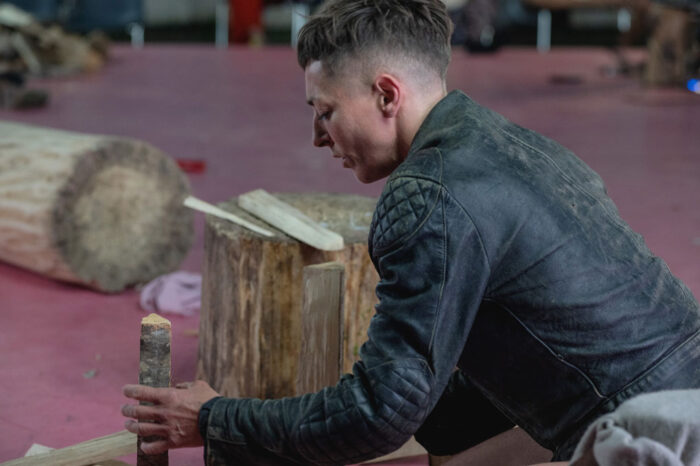
All these elements on stage have been transformed into compositional principles, in an affective score on displacement and accumulation, where the vibrating quality of the bodies is expressed through the rubbing, the use of other bodies—not simply human bodies but also many other non-human bodies. Thus, I wonder whether, right here on stage, is it possible to shift the centrality of the human? What kind of choreographic dance can we think of that is conceived by human bodies but not anthropocentric? In other words, which forces can inhabit the stage besides human ones? And what kind of movement can we learn or exchange with matter?
Simone Aughterlony: My first association in relation to the movement of matter with all the possibilities to exchange between human bodies and non-human bodies is the engagement with distinct temporalities that prescribe a slower rate of change and a slower rate of decay. The matter of the human body transforms and decays relatively fast in comparison to that of a “tree body” or the wood stumps we are working with, for example. The process of finding affinity and a real sense of being with the other bodies in the proposed landscape demands an adjustment to our dominant temporal experience, asking us to inhabit a timing that may feel unfamiliar to the kind of utilitarian and proprietary behaviour that defines an anthropocentric approach. So, this sense of tuning into another temporality and temperament demanded an attention and extreme sensibility to the qualities of the companion materials we worked with, so that their force could be rendered to stimulate our bodies and in turn the materials themselves.
You spoke of a new and political ecology being worked out between bodies and matter, between bodies and other bodies which we articulated in the practice and named as “new-sociation”. Leaning heavily on Jane Bennet’s discourse on the quality of things as vibrant beyond gestalt of use as well as infinitely unknowable we approached the bodies as if meeting them for the first time—as one might approach a new lover. This became a condition of being, becoming and moving through the landscape. A kind of encompassing while transitioning. In the practice of new-sociation, the sociality is stimulating and utterly libidinal—engaging and simultaneously reorganizing the senses of taste, smell, touch, sight, hearing to attend to the flow of perception that offers up mutable meanings and re-inscriptions of gender.
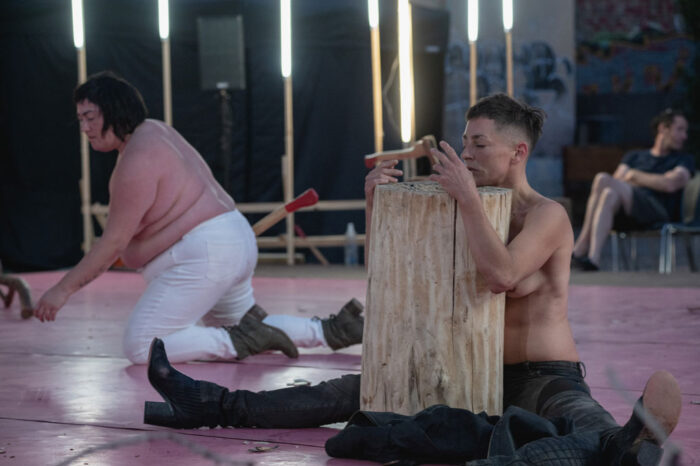
This condition of associating through extreme perception was fundamental for the emergence of what we might call dramaturgy or more precisely understanding of performative ecology which in turn gave way to various temporary assemblages, like the axe-stump-body or the lube-shirt-branch-body, for example. Things bumping into each other and cohabitating—a “being with” that didn’t try to assimilate or imitate but rather vibrate and negotiate differences in the exchange. Of course, many questions associated with assemblages, or communities for that matter, arise for the human subject in consideration of the tendency to dominate: being entangled with others, how and when to take leave and generally negotiating control and loss thereof. Part of the pleasure was to give in to the unknown in a sustained effort to offer a flow of multitudinous bodies without temporal definition. As a politic of relations, the drive was to transform the status between bodies and be transformed in the process.
Thinking about the live art space and its potential to make the invisible visible, I think back to various discussions I have had about presence and how that certain force (or in Jane Bennet’s word’s “calling”) especially as it relates to performers and how they appear to the viewer, but also to things, it remains elusive and hard to ascribe to the specificity of any one source. Through the process of making Biofiction, I came to understand that we cultivate presence by being present to the things around us. The more we attend to the qualities of things through all of our senses the more present we become and the more present others become. That actually, we needn’t be looking inside towards a sense of self to be present, but rather towards the perceptions we gather from the space and things around us. The stale dichotomy of subject/object isn’t resolved by reversing roles but perhaps by embracing thingness. Objects are the way things appear to the subject. Things on the other hand, signal the moment when the object becomes other and opens us to the uncanny and vast potential.
From a transfeminist position, a position that has been hugely elaborated in the seven years since this work was produced, there was a real effort to undo or cause rupture in many of the normative divisions such as female/male, nature/culture or subject/object through this world-building practice. Refusing these binaries was and is an active engagement in affirming ambiguity and acknowledging interdependent fluidity. It’s quite a task to keep this at play and sometimes the axe is just an axe or the human body desperately just that, especially at moments when we slip into acts of labour such as chopping wood, but the interest to find openings or cracks where some other rapport between bodies takes place was the drive that often choreographed the space or transformed bodies.
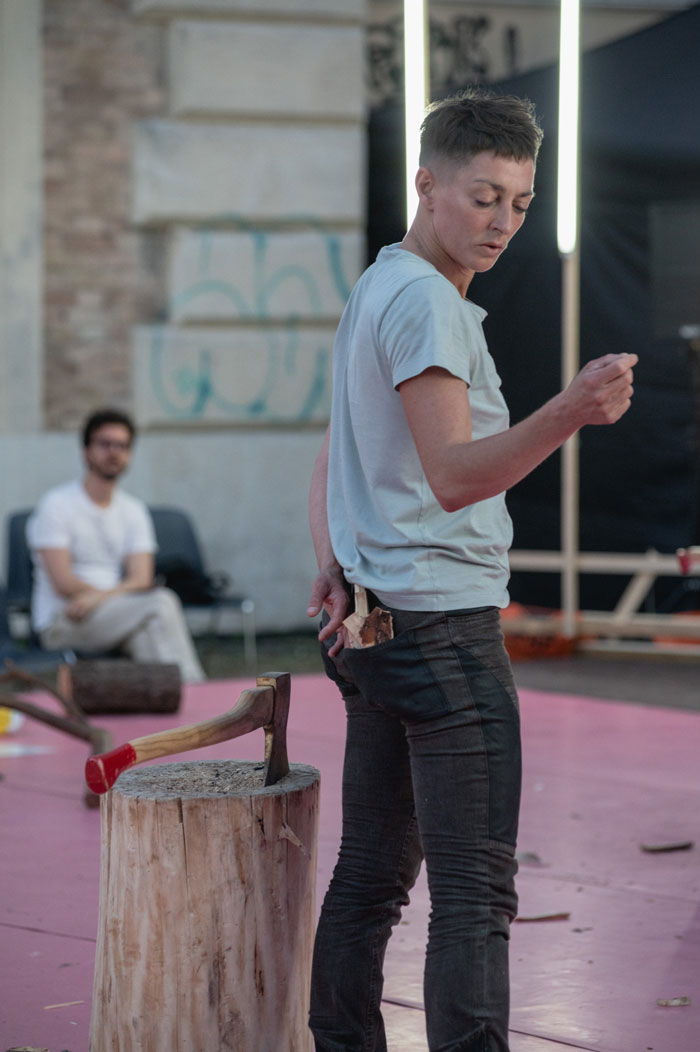
Ilenia Caleo: Another important aspect I have to think of is the erotic gear, the love gear, the sexual gear and desire. There is no representation, but new bodies are creating new desires that come to light here before us as they happen. In particular, there is a proliferation of sexual organs. Everything can be re-sexualized, everything can be re-eroticized out of the ordinary. This work is a manifesto against the dictatorship of the external genitalia, of the genital model where we are connoted as either uniquely masculine or uniquely feminine. Here instead, erogenous organs and erogenous areas are born everywhere, there is a widespread proliferation of erotic zones—of genitals. Everything fucks, so we do not take off from the idea of the genitals. M/F are no longer a possible option, certainly not here on stage. It is a contrasexual practice—as Preciado says the dildo precedes the penis. It is the penis that imitates the dildo in fucking, not the other way around. This is clearly demonstrated in this work.
However, sexuality does not belong to the human alone, it is not only of the living: what is staged here is a sexuality, as Bennett says, that is devoid of any specification. There is rather a continuous excitement, within a form of movement that is activated between living humans and apparently dead things and apparently inanimate things, “objects, stones, pieces of matter.” But also for the periphery—where a body fucks a piece of wood that screws an ax that bangs a rope that fucks some fur.
At the same time, on the notes of the show you declare that this is a work on intimacy, a love story among many—you define it, precisely a widespread non-private intimacy. The idea of intimacy is often associated with the notion of the private, thus can we think of something as a non-privatized intimacy? I see the utopian dimension of queer politics we often discuss in our communities, or whether it is possible to create non-private forms of intimacy that can be also forms of material support.
Simone Aughterlony: That is an interesting discussion. In a way, non-private forms of intimacy or at least intimacy made public has growingly offered material support in the form of visibility, recognition and misrecognition. I am thinking about the lineage of queer films, writing, pornography but maybe it is more valid to speak about the culture of cruising which has been practiced in public spaces as much as in designated spaces for those in the know. Though cruising culture may have lost some momentum due to online platforms there is certainly a nostalgia and something of a revival for this kind of non-privatized intimacy. Anonymity is still a much sought-after position, if not consciously then certainly within unconscious desire. The utopian dimension of queer politics as it relates to intimacy has in the last years been articulated through a flourishing of sex positivism discourse, practice and parties. While still, a mine field of codes and rules to navigate, the move towards a recognition of polyamorous relation (in its most expansive sense) is very promising.
Preciado’s Counter-sexual Manifesto was surely integrated on some deeper level—especially in later stages in the process as we began our dildo making factory with the wood piles. I think one of the articles in the Manifesto calls for the deconstruction and renegotiation of the border between public and private spheres as a principle of countersexual architecture which again reiterates the movement away from heterocentric ideas of private production and reproduction. However, Testo Junkie was perhaps more influential at the time, in the way this book broke with a tradition of high theory and bounced between the discursive and the re-telling of intimate sexual encounters. In a work that elevated the constant transition between genres, genders, the private and the public offered a real support to queer communities and further dissolved hard lines between stereotypical ideas of gender or genitalia as binary between masculine or feminine.
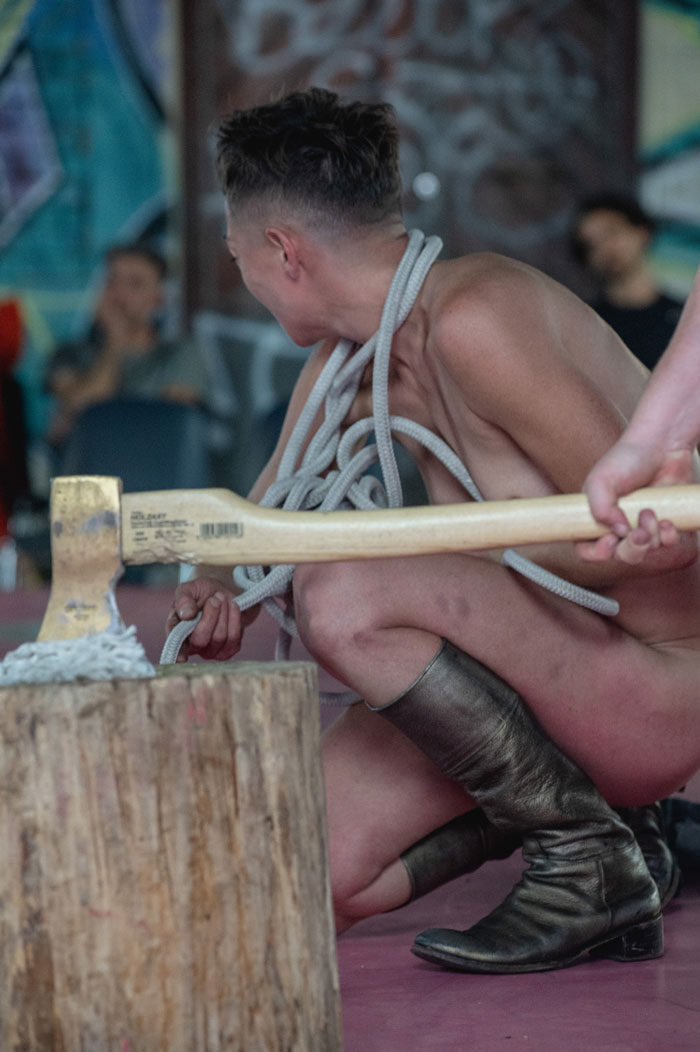
I took up the notion of cruising as a consciousness and method for moving in the world in more recent work that explored notions of the stranger. Taking a close up look at the domination of desire in a landscape of “impersonal intimacy”. Clearly, these ideas were already present in the work of Biofiction, when considering the approach to materials from a libidinal position but also from a place of the unfamiliar. The negotiation around distance, how to become proximate, how to orientate, move and stimulate are all procedures that come into play in cruising culture and in the practice of the performance.
It’s curious to hear you speak about the erotic gear because yes, it turns out that all the materials take on the potential to be hot and sexualized bodies or organs. A kind of “ism” where everything holds erotic potential and once you embrace that perspective you begin to see it everywhere—holes, dildos, moist patches, restraints all the possibilities for excitation. Strangely enough the work didn’t begin with selecting erotic or sexual gear and the more specific materials that speak to sexual acts such as lube were invited over time. Lube was our artificial stand-in for tree sap. At the genesis of the process there were tools and material that could be associated with the wilderness (or camping out) such as wood, axes, rope and tree stumps, but by nurturing this irrational love of matter as well as engaging with movement patterns that create energy between things—rubbing to make fire and all the toing and froing that we could associate with fucking or masturbation—a proliferation of sexual organs emerged. Perhaps, we escaped the trap of representation because the sexual potential was emergent from the practice rather than from so called objects. That said, I think the work also reflects a queer sexual reality which was liberating to make visible, simply as a choreographic poem without fetishizing and beyond a need to provoke.
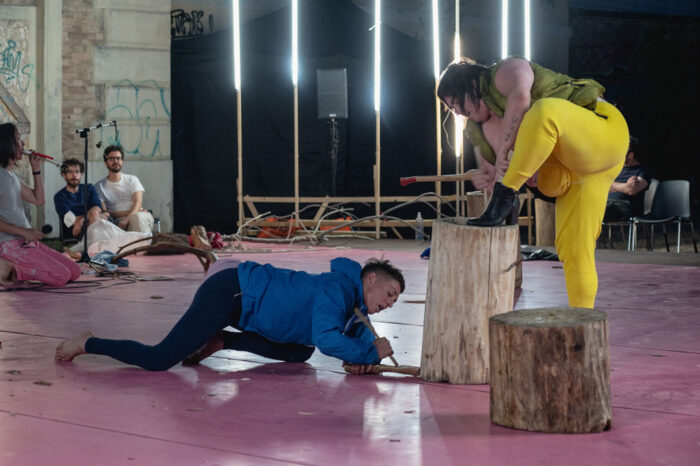
Ilenia Caleo: The last thing has to do with the idea of control, or better to say out of control, which seems to me to be very strong in your works. In this one we have seen tonight, or in your collaborative work Everything Fits in the Room (2017), there is the idea of environmental precariousness, somehow of not being able to govern all the things around. That is, there are many chances for agency, as we said. The force of things that are not only passive, as many other agencies, have much capacity to act that does not only belong to the human species. This other collaborative work, also with Jen Rosenblit alongside Gutierrez and Self on sound, Everything Fits in the Room has brought about this capacity to act along all these materials, all these tools and unusual objects. On the one hand, this brings new temporalities about, as dance and choreography, and matter is always about how we build temporalities. In this case, temporalities that are not linear—temporalities that are not narratives and do not go toward a point but are continuously unraveled and redone…
At the same time there is also a punk touch, in this way of facing the scene without wanting to completely dominate it. What do you think, is all this going towards a non-authoritarian idea of choreography that does not pretend to control—a choreography that does not control and does not govern and does not organize bodies but wants to remain open to the unexpected and the unpredictable? How do you manage to write a score leaving the door open to the unexpected? And again, how do you work on it collectively, how do your practices follow this direction?
Simone Aughterlony: That’s interesting to think about Everything Fits in the Room in relation to Biofiction because it invests in another kind of care-taking, an attention towards that which is pushed to the periphery or to what is obscured or masked, in contrast to all things exposed and treated without ontological hierarchy. While the practice engages a similar approach in that it asks how do we open ourselves to a phenomenology of things and how do we deeply experience things in our environment, Everything Fits in the Room takes on a sociopolitical frame by the simple gesture of understanding the room as a microcosm of society. The room is, after all, an architecture for organizing and reaffirming the structures that tend to mandate world-building; from the nuclear family to the education system. As a result of these normative structures we lose access to non-linear and dysfunctional practices under the rule of progress. So, the proposition in this work was how to make everything fit even when we sense this may be something of an impossibility, it was the effort that sustained us. The unraveling and redoing you refer to, began with a culture of adjusting—fixing and unfixing, bringing architectures in proximity to others, adjusting again in an effort for some other order than disorder. Each thing in the room functions as a scaffolding to connect and reach other things. Maybe we are reiterating differently an underlying politic present in Biofiction: the inherent interdependency of all things, despite our tendency to dominate and ignore what becomes marginalized or undervalued.
The punk element you mention I would attribute to the long research and devising process, common to a lot of my performances and collaborations. What looks accidental or happenstance is actually designed and rehearsed to look so. We made many iterations of the practice in studios, galleries, workshop formats with and without the free-standing brick wall that is built in the room, which all contributed to an understanding of how to manage the room without suffocating the ideas it wants to convey. Even when the unpredictable or unexpected appears, as it often does when working with dangerous materials, we had months of experience with such incidences appearing and can remain in the practice of adjusting to the event. It is written into the score and familiar to the practice. The ungovernability of the room is a reality but there is also an invitation to guests that we try to take care of and build an experience over a certain time frame. The practice became a show that was organized for the guests with a lot of imagination and planning around how they might navigate the room and its revolving proposition of the central wall. More generally, my choreographic practice embraces a sense of non-arrival or not completeness, often strongly orientating towards an idea that becomes saturated and reorientates—perhaps this movement that contradicts is the content that helps to avoid the authoritarian stance. The full stop, the final statement.
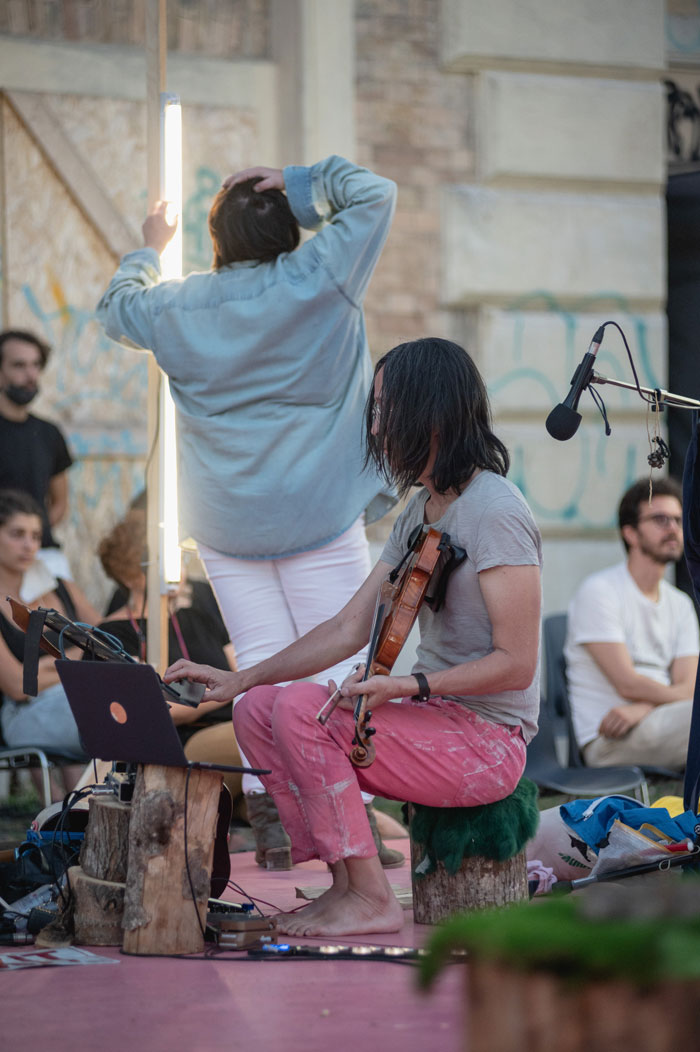
Thinking about the invitation to the guests provided the stimulus to carve a dramaturgy for the event—imagining the kind of atmosphere you might want guests to arrive for. We choose confidence and a sense that one might be entering something that is already happening. Working intimately with the soundbody (Miguel and Colin) to treat the room with each section of the score, we moved through phases and their accompanying material that were named domestic, cooking, machine, siren, 5am the kids are in bed or the folkloric, and finally return to the ordinary. The score literally built itself through returning to the past experience and acknowledging the elements that we wished would return in some way or with some body but also spanning a condensed sense of a day/night and the kind of labour and pleasure that might happen in the course of that time frame. Because the practice demands a multi-tasking of attention/distraction within the care-taking we had a certain capacity to see events happening, watch each other and articulate in language what had transpired. In this sense, we could collectively build the discourse and associated practice over time. Additionally, we invited a guest to perform with the four of us in each city where the work was presented. The guest held something of a liminal position in that they had a certain amount of information—we worked several days with the guest before the performance—but certainly not the familiarity and knowledge with the practice we had developed. I guess, the guest was like a second cousin removed if we apply the logic of the familial structure. The guest offered a contradiction and a welcomed disruptive position within the performance and hopefully through the specificity of the invitation further problematized the commitment to make everything fit.




